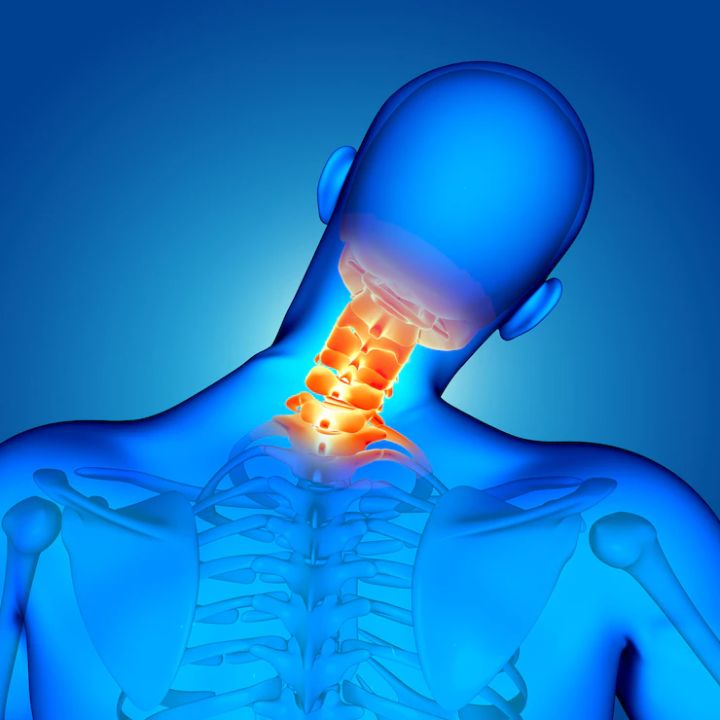Cervical facet joint pain is a common condition that affects the cervical spine and can cause neck pain, stiffness, and reduced range of motion. This condition can be caused by a variety of factors, including facet joint inflammation, arthritis, joint dysfunction, and nerve involvement.
Symptoms of cervical facet joint pain can vary but often include neck pain that worsens with sudden movement, stiffness, headaches, and pain that radiates to the shoulders or upper back. If left untreated, cervical facet joint pain can lead to chronic pain and disability. However, there are several treatment options available to manage and relieve symptoms.
Various factors, including arthritis, joint dysfunction, muscle strain, nerve involvement, and degeneration, can cause cervical facet joint pain.

Photo Credit: kjpargeter
Arthritis is a common cause of cervical facet joint pain. Two types of arthritis can impact the facet joints in the cervical spine: osteoarthritis and rheumatoid arthritis. Osteoarthritis is caused by the wear and tear of joint cartilage over time. Rheumatoid arthritis, on the other hand, is an autoimmune disease that can affect various joints in the body, including the facet joints in the spine.
Cervical facet joint dysfunction occurs when the joints become misaligned or damaged. This can be caused by trauma, poor posture, or overuse. Dysfunctional joints can cause pain and stiffness in the neck and shoulders.
Facet joint blocks are a common diagnostic procedure used to determine the source of cervical facet joint pain. This involves injecting a small anesthetic into the joint to numb the area. If the pain subsides after the injection, it confirms that the facet joint is the source of the pain.
Facet joint injections, also known as medial branch blocks, can be used to manage the pain associated with cervical facet joint inflammation. This involves injecting a steroid medication directly into the area surrounding the joint to reduce inflammation and provide pain relief.
In some cases, nerve ablation techniques may be used to manage the pain associated with cervical facet joint dysfunction. This involves using heat or cold to destroy the nerves that transmit pain signals to the brain. This can provide long-term relief for individuals suffering from chronic cervical facet joint pain.
Understanding the causes of cervical facet joint pain and utilizing appropriate diagnostic procedures are essential for developing an effective treatment plan.
Individuals experiencing cervical facet joint pain may present with a range of symptoms that can vary in severity. The symptoms can be attributed to a variety of factors such as facet joint osteoarthritis, facet joint capsule issues, and the involvement of medial branches and denervation.
Cervical facet joint osteoarthritis is a common cause of pain and discomfort in the neck and upper back. The condition occurs when the cartilage between the facet joints wears down, causing the bones to rub against each other.

Photo Credit: peoplecreations
Symptoms of facet joint osteoarthritis may include stiffness, decreased range of motion, and deep, aching pain that worsens with activity.
The facet joint capsule is a tough, fibrous tissue that surrounds the joint. When the joint capsule is inflamed or irritated, it can cause significant pain and discomfort. Symptoms of facet joint capsule issues may include a sharp, stabbing pain when moving the neck, stiffness, and swelling around the affected joint.
The facet joints are richly innervated by small nerves known as medial branches. When these nerves become irritated or damaged, they can cause pain and discomfort in the neck and upper back. Symptoms of medial branch involvement may include aching, burning, or sharp pain that radiates out from the affected joint.
Denervation refers to the loss of nerve supply to a given area. In the case of cervical facet joint pain, denervation can occur when the medial branches that supply the joint are damaged or destroyed. Symptoms of denervation may include a loss of sensation or weakness in the affected area and chronic pain that is difficult to manage.
Cervical facet joint pain can be managed with a variety of treatments, depending on the severity of the condition. Some of the treatment options available are:
Pain management techniques such as heat therapy, ice therapy, and medication can help alleviate discomfort and inflammation associated with cervical facet joint pain.

Photo Credit: Racool_studio
Physical therapy is a common treatment option for cervical facet joint pain. A physical therapist can create a customised exercise plan to strengthen the muscles surrounding the affected joint and improve range of motion.
Rhizotomy uses radiofrequency waves to damage the nerves that transmit pain signals to the brain. This can provide long-term pain relief for individuals with cervical facet joint pain.
Synovial cysts can cause cervical facet joint pain by compressing nerves in the spinal column. In cases where a synovial cyst is causing pain, surgery may be necessary to remove the cyst.
Facet joint injections involve injecting a local anaesthetic and anti-inflammatory medication into the affected joint. This can provide temporary pain relief and help diagnose the root cause of the pain.
Facet joint denervation involves disabling the nerves that transmit pain signals in the affected joint. This can provide long-term pain relief for individuals with cervical facet joint pain.
It’s important to note that treatment options for cervical facet joint pain may vary depending on the individual’s medical history and the severity of their condition. Consulting with a medical professional is always recommended before pursuing any treatment plan.
Invasive procedures are typically reserved as a last resort for extreme cases of cervical facet joint pain. However, they can be highly effective at reducing pain and improving quality of life in certain individuals.
Facet joint hypertrophy is a condition where the facet joints become enlarged due to arthritis or other degenerative conditions.

Photo Credit: gpointstudio
This can put pressure on nearby nerves and cause pain and discomfort. One treatment option is a minimally invasive facet joint radiofrequency ablation, which uses heat to destroy the nerves causing the pain.
In some cases, a surgical approach may be necessary to address cervical facet joint pain. This involves understanding the anatomy of the facet joint and how it may be contributing to pain. For example, suppose there is a problem with the joint itself. In that case, a cervical facet joint fusion may be recommended to permanently connect the two vertebrae on either side of the affected joint.
Over time, the facet joints can become worn down and degenerate, leading to pain and discomfort. In some cases, a facet joint replacement may be recommended to remove and replace the damaged joint with an artificial one. However, this procedure is highly invasive and only recommended in severe cases where other treatment options have failed.
While invasive cervical facet joint pain procedures are not typically the first line of treatment, they can be highly effective at reducing pain and improving quality of life in certain individuals. Always consult a healthcare provider to determine the best treatment plan for your needs.
For those who prefer non-invasive treatment options, several alternatives can provide relief from cervical facet joint pain. These treatments include:
Facet joint injections with steroids can temporarily relieve pain and inflammation. This injection delivers a mixture of a long-lasting local anesthetic and a steroid medication to the facet joint. Depending on the individual, this may provide relief for several weeks or sometimes months.
Joint impingement can cause cervical facet joint pain. A physical therapist can work with individuals to reduce stiffness and improve mobility in the affected area. This can reduce pressure on the joint, which can alleviate pain and discomfort.
Cervical facet joint block injection involves injecting a local anesthetic into the joint. This can help reduce pain in the joint, and provide relief from inflammation. This injection may need to be repeated several times to achieve the desired level of relief.
Facet joint nerve ablation, also known as radiofrequency ablation, involves using an electrical current to destroy the nerves responsible for transmitting pain signals from the joint. Depending on the individual, this procedure can provide long-term relief, ranging from several months to years.
It is important to note that while these non-invasive treatments can provide relief, they may not completely eliminate pain and discomfort. In some cases, a combination of treatments may be necessary to effectively manage cervical facet joint pain.

Photo Credit: Freepik
In addition to medical treatments, there are several self-care and lifestyle tips that can help provide relief from cervical facet joint pain.
Exercise and stretching can help improve the flexibility and strength of the muscles supporting the cervical spine, which can reduce pressure on the facet joints. Low-impact exercises such as walking, swimming, and cycling are recommended, as high-impact exercises can exacerbate joint pain.
Stretching the neck, shoulders, and upper back can also help improve range of motion and reduce tension in the muscles. However, consulting with a healthcare professional before beginning any exercise or stretching program is important.
Poor posture can place additional stress on the cervical facet joints, worsening pain and discomfort. Maintaining good posture, particularly when sitting at a desk or computer for long periods of time, can help alleviate pressure on the joints. Ergonomic chairs, desks, and computer accessories can also help promote good posture.
Applying heat or cold to the affected area can help reduce inflammation and pain. Heat therapy, such as using a heating pad or taking a warm bath, can help relax muscles and improve blood flow to the area. Cold therapy, such as using a cold pack or ice wrapped in a towel, can help reduce swelling and numb the area, providing temporary pain relief.
Stress can exacerbate cervical facet joint pain by increasing tension in the muscles supporting the neck and spine. Practicing stress-management techniques, such as deep breathing, meditation, or yoga, can help reduce stress levels and promote relaxation, potentially reducing pain and discomfort.
Sleeping in an uncomfortable or unsupportive position can worsen cervical facet joint pain. Sleeping on the back or side with a supportive pillow can help maintain proper spinal alignment and reduce pressure on the joints. Avoid sleeping on the stomach, as this can hyperextend the neck and strain the joints.
By incorporating these self-care and lifestyle tips into daily routines, individuals with cervical facet joint pain may experience some relief from symptoms. It’s important to consult with a healthcare professional before starting any new treatment or lifestyle changes.
Cervical facet pain often presents with the following symptoms:
Treatment for cervical facet joint pain can involve:
Cervical facet joint pain can be aggravated by:
The C5-C6 facet joints are located in the lower part of the neck. Pain in these joints can lead to: